HTC One S Review - International and T-Mobile
by Brian Klug on July 17, 2012 9:30 AM ESTWe’ve already seen 1.5 GHz dual core Krait (MSM8960/MSM8260A/MSM8660A) performance before and talked about it in the HTC One X (AT&T) review, and the USA SGS3 review. For the most part, what we see with the HTC One S variants is largely the same as what we saw with a number of other dual core Krait based devices. Recall that MSM8960, MSM8660A, and MSM8260A differ only in baseband and thus what air interfaces are supported. The only big difference between the devices we've seen based on that SoC so far is RAM, and again the HTC One S includes 1 GB of LPDDR2.
If you’re looking for a detailed comparison to the International SGS3 with Exynos 4412, I've finally had a chance to play with one and we will be doing a more direct comparison with Tegra 3, Exynos 4412, and dual core Krait shortly. I've tossed in the numbers from the International SGS3 for comparison already.
For now, however, let's talk about the HTC One S.
JavaScript Performance
Measuring JavaScript performance is just one component of overall web browsing performance, but it’s the most mature in terms of something we can benchmark. Sunspider 0.9.1 is quite possibly the most well known of these JavaScript tests, and a regular staple of our testing suite:
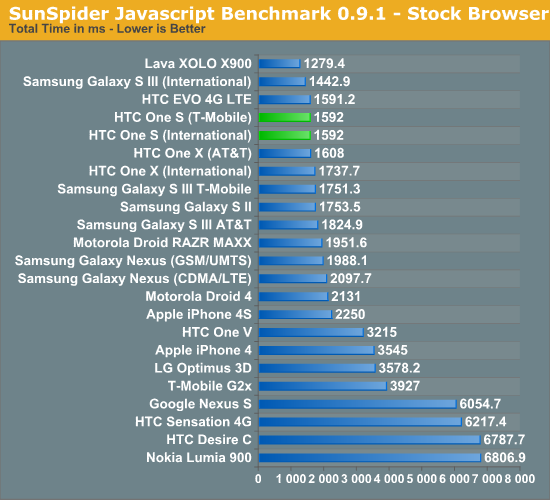
There's an obvious grouping of 1.5 GHz dual core Krait devices around 1500 ms. What spread there is between devices is primarily a function of whatever tweaks OEMs have made to the stock browser's V8 JavaScript engine.
Next up is Browsermark, which is another primarily JavaScript benchmark, with a few other measures. I'm told there are future versions planned which target HTML5 canvas performance.
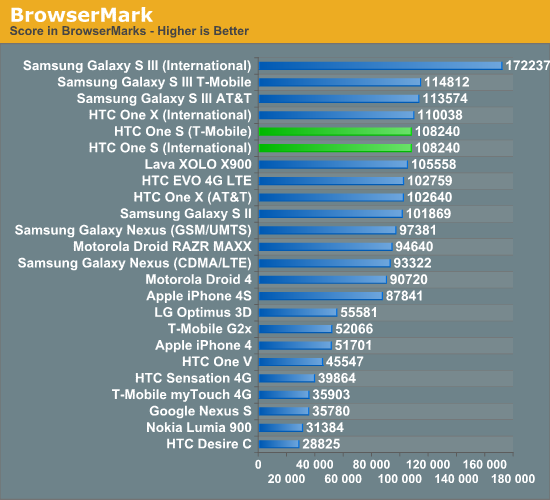
Again there's an obvious clump of dual core Krait devices. The International SGS3 pulls way ahead here for some reason.
Next up is Vellamo, which is a Qualcomm benchmark developed originally for OEMs to use and optimize their browser performance with, and later released for general use. It’s a regular member of our test suite and includes both JavaScript tests and scrolling tests that stress the display composition and hardware acceleration in an Android WebView.

Unsurprisingly the Qualcomm based devices do well in their own benchmark. All of the devices that score above 2000 feel very smooth browsing around in the stock browser and WebView. For the most part, choppy translation and zoom is a thing of the past on Android 4.x.
Low Level FP Performance
Linpack isn’t a great indication of overall smartphone performance, but it is a good test of the floating point capabilities of the CPUs in these SoCs. ARM has steadily been improving FP performance for the past few generations but we’re going to see a big jump to Krait/A15. As most client smartphone workloads are integer based and those that are FP heavy end up relying on the GPU, an advantage here doesn’t tell us much today (particularly because Linpack isn’t running native code but rather atop Dalvik) other than how speedy the FPUs are. There’s a new port of Linpack which runs using native code which we’ll be trying out in the big performance comparison piece.
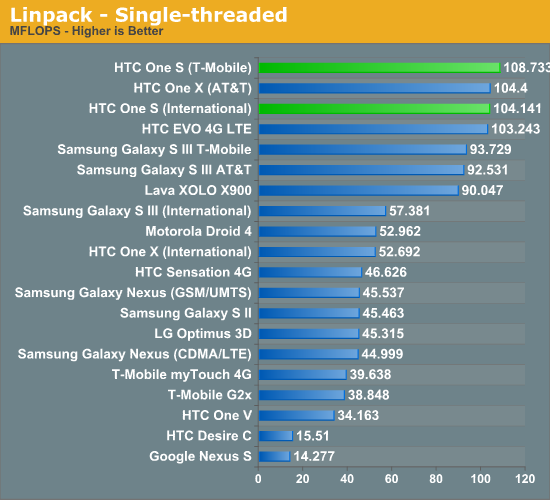
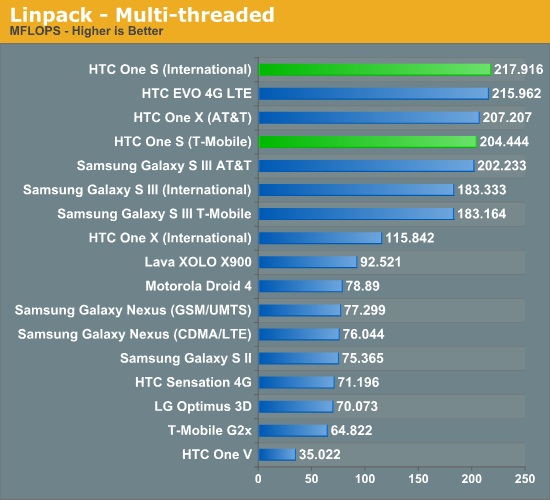
I'm becoming more and more dissatisfied with this GreeneComputing build of Linpack, and given the availability of some alternatives which are implemented natively as opposed to atop Dalvik, will probably move away from it very soon.
BaseMark OS
Rightware’s BaseMark OS is a general purpose benchmark designed to better simulate overall Android performance. It includes a heavily threaded benchmark, file IO tests, and compression/decompression tasks that all contribute to its overall score. This benchmark is pretty much the closest thing we have to a system benchmark for Android at this point, and is very close to achieving the same level of adoption that a few other big industry benchmarks have.
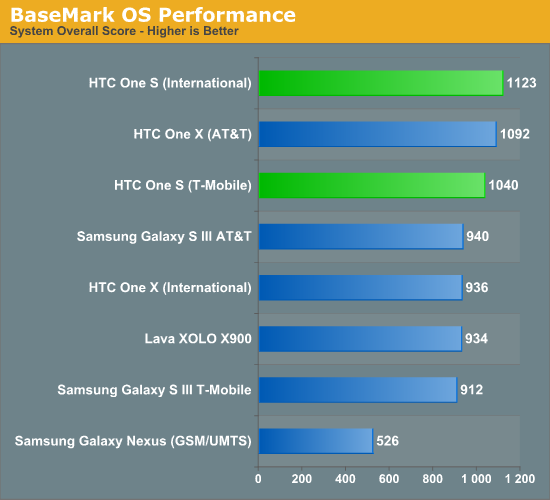
GPU Performance - GLBenchmark 2.1
As we wait for actual 3D gaming benchmarks to make their way into Android (and hopefully cross platform) games, we must rely on synthetic tests designed to simulate 3D game performance as best as possible. We start with GLBenchmark, one of the better Android GPU tests on the market today. There are two benchmarks, Egypt and Pro, and each is run in two modes: native screen resolution and offscreen (vsync disabled) at 720p. The latter is more useful for apples to apples comparisons as everything is rendering the same number of pixels, whereas performance in the onscreen tests is determined by the screen resolution of the device along with the performance of its GPU.
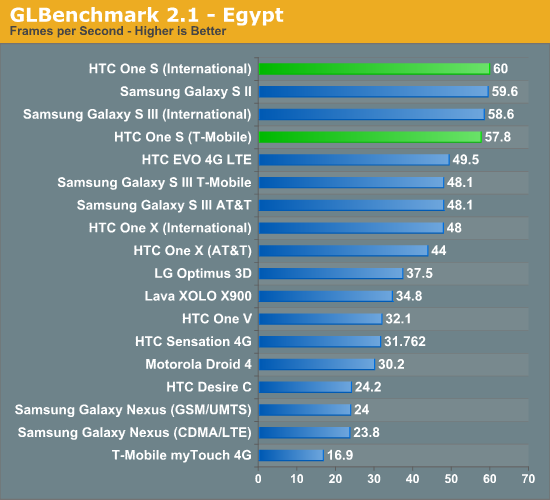

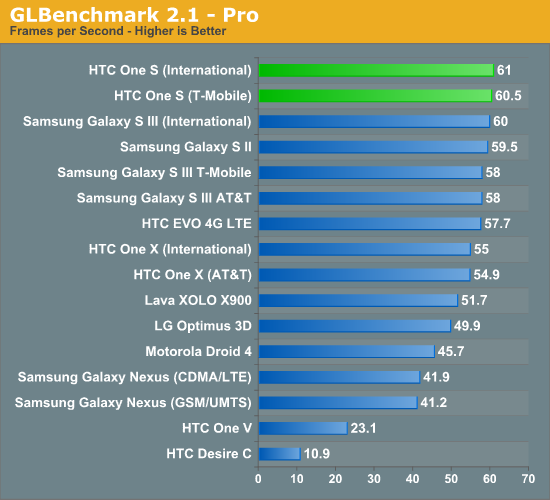
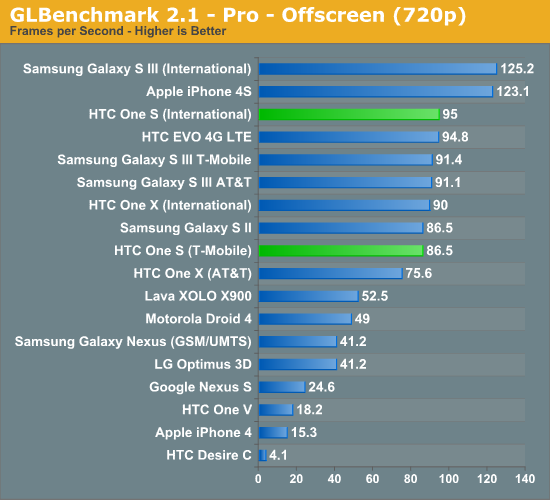
As a reminder, only the offscreen tests take place with vsync turned off, which is why you see devices with 720p displays posting different results on versus off screen where vsync is off. Part of the deal in getting Krait to market as quickly as possible required that Qualcomm pair the CPU with an older GPU, in this case the Adreno 225 instead of the newer Adreno 3xx offerings due out later this year in SoCs like MSM8960 Pro or the quad core Krait APQ8064. As a result, you can see the SGS2 with Exynos 4210 and the SGX543MP2 in the iPhone 4S pull ahead in some tests. Obviously the on-screen test isn’t a totally fair comparison because of the inherent difference in resolution - the One S is qHD.
Basemark ES 2.0 V1
Rightware’s Basemark ES 2.0 V1 is an aging GPU test that tends to favor Qualcomm’s Adreno GPUs above almost all others:
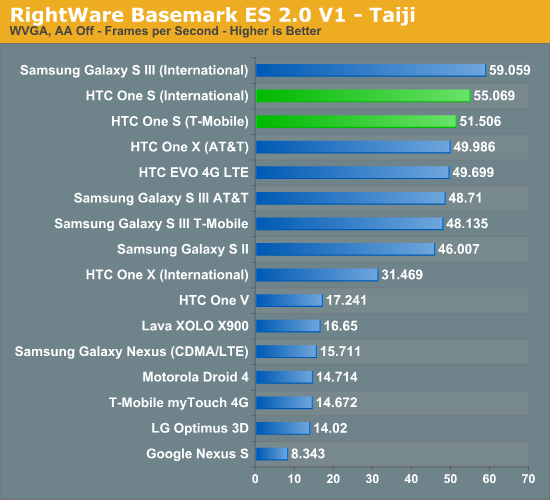
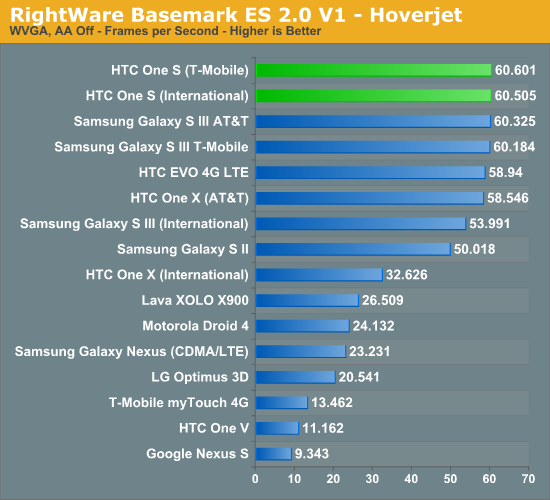
These two tests we run at WVGA on the device. Basemark ES 2.0 is definitely starting to show its age, as Hoverjet is at vsync essentially the whole time, and Taiji is nearly there as well. Qualcomm appears to be using ES 2.0 as an optimization target, so I wouldn’t put too much faith in the ES 2.0 results.










97 Comments
View All Comments
Death666Angel - Thursday, July 19, 2012 - link
4.3" is my normal. 4.0" is really the smallest I could imagine going. iPhones 3.5" is just unacceptable for my usage case and hands. The Note was not that bad, though I only tried it in the shop. 4.6"/4.7" will probably replace my SGS2 in a year or so.ausaras - Tuesday, July 17, 2012 - link
I seriously doubt the AMOLED screen in One S is from SAMSUNG, not after SAMSUNG screwed HTC over.I have read news in Taiwan several months ago that AUO is working on AMOLED screens. After reading this article, I Googled a bit and found several sources (in English and Chinese) that AUO indeed is shipping AMOLED screens at the second half of 2012, to HTC and Sony.
If any reader here is from Taiwan, it should be apparent that the Asian IT industry is in the mist of change. Taiwanese and Japanese companies are forming alliances against the SAMSUNG juggernaut. Another reason why I doubt the AMOLED screen in One S is from SAMSUNG.
tynopik - Tuesday, July 17, 2012 - link
when i saw the pic out of the corner of my eye, i thought it was some sort weird combo phone that joined two regular phones with some metal scaffoldingJohnmcl7 - Wednesday, July 18, 2012 - link
I'm glad it wasn't just me, I was trying to figure out what on earth the phone was as it looked like some sort of strange double phone attached with a metal hinge from the picture.John
dishayu - Wednesday, July 18, 2012 - link
I love this phone. It's perfect for me. I was waiting for 3 months to be able to buy it, but then all of a sudden, HTC decided to bait and switch and now India has a One S with 1.7 Ghz Scorpion processor, unlike the krait in international version. VERY disappointed.Zoomer - Thursday, July 19, 2012 - link
They pulled a Samsung? Damn.M0rky - Wednesday, July 18, 2012 - link
What countries is this One S international sold in? The version sold in Europe and Asia has a S3 cpu running at 1.7Ghz. I can´t find a single review of this version and as far as I can tell the S4 version is only sold in America.pikahatonjon - Wednesday, July 18, 2012 - link
is the screen in the galaxy nexus and the galaxy s 3 the exact same?because i heard reports that the galaxy s 3 one is a bit more bright, but with franco's custom kernel and with the trinity kernal for the galaxy nexus, i can get it really bright. perhaps brighter than the 200 nits that you mentioned in this review. could you possible investigate?
http://forums.anandtech.com/showthread.php?t=22579...
azntwboy - Wednesday, July 18, 2012 - link
So, according to your measurements, this screen has a color gamut of something like 130% sRGB? How does that actually look? Are the colors super saturated? How does it compare with the HTC X and the Google Nexus 7? Can you please provide a graphic with the color gamuts overlaid so it's easier to compare?One issue I have with all new phones is that they don't have replaceable batteries. I use my phone for both displaying photos for work, and GPS navigation for hiking, so I need to be able to run it for 8 days at a time. I have a HTC desire and I take 8 batteries with me for a week long hike. I wonder if a solar panel charger is something I could use instead of replaceable batteries.
dishayu - Wednesday, July 18, 2012 - link
There are 12000 mAH USB battery packs on the market selling for around 60$ that you can carry along. IMO it's much more convinient than carrying 8 batteries and also a lot more versatile because you can use any USB chargable device with them.But i do agree, user replacable battery is one option i'd like to have as well, because ultimately when the battery performance starts to detoriate after months of usage, there's no other way.